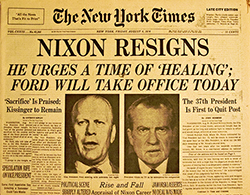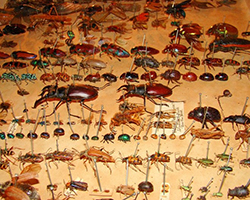MENU
The Electronic Scholarly Publishing Project: Providing access to classic scientific papers and other scholarly materials, since 1993. More About: ESP | OUR CONTENT | THIS WEBSITE | WHAT'S NEW | WHAT'S HOT
Comparative Timelines
The ESP Timeline (one of the site's most popular features) has been completely updated to allow the user to select (using the timeline controls above each column) different topics for the left and right sides of the display.
Select:
New Left Column
New Left Column
Dates
Decade
New Right Column
New Right Column
 Dr. Clifton Wharton Junior is named president of Michigan State University on January 2. He is the first African-American to lead a major, predominantly white university in the 20th century.
Dr. Clifton Wharton Junior is named president of Michigan State University on January 2. He is the first African-American to lead a major, predominantly white university in the 20th century.
1970
(no entry for this year)
On January 12, the Congressional Black Caucus is formed in Washington DC.
1971
Five pairs of adult wall lizards are moved between two islands in Croatia. Over the next few decades, the lizards on the new island will evolve larger heads, stronger bites, and a greater tolerance for an herbivorous diet than the original lizard population.
A. G. Sharov describes a pterosaur with fossil "hair" impressions as Sordes pilosus (hairy devil).
Grad student Douglas Lawson discovers the humerus of a giant pterosaur in Texas. Over the next four years, he will continue collecting and finally publish a description of Quetzalcoatlus northropi, the largest flying animal ever found, with an estimated wingspan of 39 feet.
Polish and Mongolian paleontologists discover the entwined skeletons of a Protoceratops and a juvenile Velociraptor in the Gobi Desert, most likely locked in mortal combat.

 In November, Barbara Jordan of Houston and Andrew Young of Atlanta become the first black Congressional representatives elected from the US South since 1898.
In November, Barbara Jordan of Houston and Andrew Young of Atlanta become the first black Congressional representatives elected from the US South since 1898.
1972
Stephen Jay Gould and Niles Eldredge publish their theory of punctuated equilibrium, stating that evolution often occurs in short bursts, followed by long periods of stability.
Bob Bakker publishes "Anatomical and Ecological Evidence of Endothermy in Dinosaurs" in Nature, arguing that dinosaurs were warm-blooded animals.
Harry Whittington shows a preliminary reconstruction of the Burgess Shale species Opabinia at a Palaeontological Association meeting, and the crowd roars with laughter.
 In the late summer of 1973, Republican Vice President Spiro Agnew was under investigation by the United States Attorney's office in Baltimore, Maryland, on charges of extortion, tax fraud, bribery and conspiracy. In October, he was formally charged with having accepted bribes totaling more than $100,000, while holding office as Baltimore County Executive, Governor of Maryland, and as Vice President of the United States. On October 10, 1973, Agnew was allowed to plead no contest to a single charge that he had failed to report $29,500 of income received in 1967, with the condition that he resign the office of Vice President. Agnew is the only Vice President in U.S. history to resign because of criminal charges.
In the late summer of 1973, Republican Vice President Spiro Agnew was under investigation by the United States Attorney's office in Baltimore, Maryland, on charges of extortion, tax fraud, bribery and conspiracy. In October, he was formally charged with having accepted bribes totaling more than $100,000, while holding office as Baltimore County Executive, Governor of Maryland, and as Vice President of the United States. On October 10, 1973, Agnew was allowed to plead no contest to a single charge that he had failed to report $29,500 of income received in 1967, with the condition that he resign the office of Vice President. Agnew is the only Vice President in U.S. history to resign because of criminal charges.
 Thomas Bradley is elected the first black mayor of Los Angeles in the modern era. He is reelected four times and thus holds the mayor's office for 20 years.
Thomas Bradley is elected the first black mayor of Los Angeles in the modern era. He is reelected four times and thus holds the mayor's office for 20 years.
1973
Half in jest, Francis Crick and Leslie Orgel suggest that ancient aliens may have seeded the early Earth with DNA, and all life on this planet arose from that.
Peter and Rosemary Grant begin a long-term study of finches on the Galápagos Islands. In succeeding years, as they watch finches adapt to alternating wet and dry conditions, the Grants will uncover evidence that evolution proceeds more rapidly than what Darwin estimated.
Taking a line from Through the Looking Glass, Leigh Van Valen establishes the "Red Queen" hypothesis of coevolution between predator and prey: "it takes all the running you can do, to keep in the same place. If you want to get somewhere else, you must run at least twice as fast as that!"
Heinz Tobien collects a primate tooth fragment from limestone rocks in southern Germany. Studies published decades later, in 2001 and 2011, will suggest that the fossil is 17 million years old, and that a hominoid migration into Eurasia occurred 3 million years earlier than previously thought.
 Under mounting impeachment pressure resulting from the Watergate break-in, Nixon becomes the first president ever to resign from presidency.
Under mounting impeachment pressure resulting from the Watergate break-in, Nixon becomes the first president ever to resign from presidency.
 Gerald Ford becomes thirty-eighth president of the United States.
Gerald Ford becomes thirty-eighth president of the United States.
1974
Donald Johanson and his team discover a female fossil hominid (to be later named Australopithecus afarensis) and call her Lucy. Lucy's discovery establishes that hominids walked upright before developing large brains, overturning some long-held beliefs about hominid evolution. Her status as a direct ancestor of modern humans, however, will remain controversial.
Heavy equipment operator Porky Hansen accidentally uncovers a mammoth tusk while leveling ground for a building. The site will reveal many more mammoths, becoming a tourist attraction for Hot Springs, South Dakota.
John Ostrom publishes a paper titled "Archaeopteryx and the Origin of Flight" reviving Thomas Henry Huxley's arguments from the 1860s.
(no entry for this year)
1975
Mary-Claire King and Allan Wilson publish their finding that human and chimpanzee DNA sequences differ by roughly 1 percent, meaning humans have more in common with chimps than chimps do with gorillas. King and Wilson suggest that humans and chimps differ largely in the DNA that switches on and off genes.
Armed with an old geological map, selt-taught fossil hunter Joan Wiffin finds New Zealand's first recognized dinosaur fossil, a theropod tail vertebra, in the Maungahouanga Valley.
(no entry for this year)
1976
Overturning the classifications introduced by R. H. Whittaker seven years earlier, Carl Woese proposes to divide all living things into three categories: Bacteria, Archaea and Eukarya.
Paleontologists looking for cave bear remains explore Sima de los Huesos ("Pit of the Bones") at Atapuerca, Spain. For many years afterwards, it will remain the densest accumulation of fossil human bones ever discovered, including the remains of more than 30 Homo heidelbergensis individuals.
 The eighth and final night for the televised miniseries based on Alex Haley's Roots is shown on February 3. This final episode achieves the highest ratings to that point for a single television program.
The eighth and final night for the televised miniseries based on Alex Haley's Roots is shown on February 3. This final episode achieves the highest ratings to that point for a single television program.
Jimmy Carter becomes thirty-ninth president of the United States.
1977
Submersible vehicle Alvin reveals deep sea vents on the ocean floor that give rise to an ecosystem owing nothing to photosynthesis. This finding prompts speculation that life on Earth first arose in deep-sea, not shallow-water, ecosystems.
Fred Sanger and collaborators publish the first complete DNA sequence of an organism, a bacteriophage, or virus infecting bacteria.
(no entry for this year)
1978
J. W. Kitching discovers a clutch of prosauropod eggs in South Africa, the oldest dinosaur embryos yet found. They will show that sauropods walked on all fours as small animals, but the significance of this find will be overlooked for nearly three decades.
Mary Leakey announces the discovery of fossil footprints at Laetoli demonstrating that hominids walked upright 3.6 million years ago.
 On March 28, a partial core meltdown occurred in Unit 2 of the Three Mile Island Nuclear Generating Station in Dauphin County, Pennsylvania near Harrisburg.
On March 28, a partial core meltdown occurred in Unit 2 of the Three Mile Island Nuclear Generating Station in Dauphin County, Pennsylvania near Harrisburg.
1979
 Fresh out of law school and short on cash, Robert Heggestad buys an antique cabinet on an installment plan from a Virginia antique shop. The cabinet turns out to contain some 1,700 plant and invertebrate specimens from the personal collection of Alfred Russel Wallace.
Fresh out of law school and short on cash, Robert Heggestad buys an antique cabinet on an installment plan from a Virginia antique shop. The cabinet turns out to contain some 1,700 plant and invertebrate specimens from the personal collection of Alfred Russel Wallace.
Crystal Bennett finds a human-altered sea urchin fossil in Islamic (Fatimid) deposits dating from the 10th to 12th centuries in the Amman Citadel.
ESP Quick Facts
ESP Origins
In the early 1990's, Robert Robbins was a faculty member at Johns Hopkins, where he directed the informatics core of GDB — the human gene-mapping database of the international human genome project. To share papers with colleagues around the world, he set up a small paper-sharing section on his personal web page. This small project evolved into The Electronic Scholarly Publishing Project.
ESP Support
In 1995, Robbins became the VP/IT of the Fred Hutchinson Cancer Research Center in Seattle, WA. Soon after arriving in Seattle, Robbins secured funding, through the ELSI component of the US Human Genome Project, to create the original ESP.ORG web site, with the formal goal of providing free, world-wide access to the literature of classical genetics.
ESP Rationale
Although the methods of molecular biology can seem almost magical to the uninitiated, the original techniques of classical genetics are readily appreciated by one and all: cross individuals that differ in some inherited trait, collect all of the progeny, score their attributes, and propose mechanisms to explain the patterns of inheritance observed.
ESP Goal
In reading the early works of classical genetics, one is drawn, almost inexorably, into ever more complex models, until molecular explanations begin to seem both necessary and natural. At that point, the tools for understanding genome research are at hand. Assisting readers reach this point was the original goal of The Electronic Scholarly Publishing Project.
ESP Usage
Usage of the site grew rapidly and has remained high. Faculty began to use the site for their assigned readings. Other on-line publishers, ranging from The New York Times to Nature referenced ESP materials in their own publications. Nobel laureates (e.g., Joshua Lederberg) regularly used the site and even wrote to suggest changes and improvements.
ESP Content
When the site began, no journals were making their early content available in digital format. As a result, ESP was obliged to digitize classic literature before it could be made available. For many important papers — such as Mendel's original paper or the first genetic map — ESP had to produce entirely new typeset versions of the works, if they were to be available in a high-quality format.
ESP Help
Early support from the DOE component of the Human Genome Project was critically important for getting the ESP project on a firm foundation. Since that funding ended (nearly 20 years ago), the project has been operated as a purely volunteer effort. Anyone wishing to assist in these efforts should send an email to Robbins.
ESP Plans
With the development of methods for adding typeset side notes to PDF files, the ESP project now plans to add annotated versions of some classical papers to its holdings. We also plan to add new reference and pedagogical material. We have already started providing regularly updated, comprehensive bibliographies to the ESP.ORG site.
ESP Picks from Around the Web (updated 06 MAR 2017 )
Old Science

Weird Science

Treating Disease with Fecal Transplantation
Fossils of miniature humans (hobbits) discovered in Indonesia

Dinosaur tail, complete with feathers, found preserved in amber.
Astronomy

Mysterious fast radio burst (FRB) detected in the distant universe.